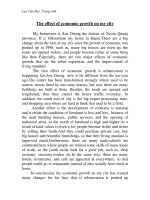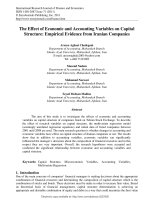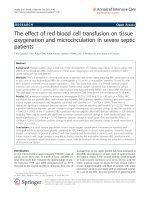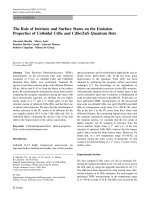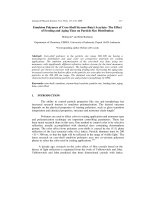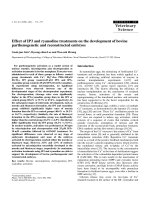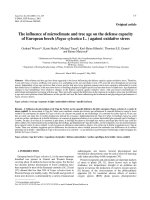The effect of economic and accounting variables on capital structure empirical evidence from iranian companies
Bạn đang xem bản rút gọn của tài liệu. Xem và tải ngay bản đầy đủ của tài liệu tại đây (79.84 KB, 7 trang )
Electronic copy available at: />International Research Journal of Finance and Economics
ISSN 1450-2887 Issue 71 (2011)
© EuroJournals Publishing, Inc. 2011
The Effect of Economic and Accounting Variables on Capital
Structure: Empirical Evidence from Iranian Companies
Arezoo Aghaei Chadegani
Department of Accounting, Mobarakeh Branch
Islamic Azad University, Mobarakeh, Isfahan, Iran
E-mail:
Tel: ++60173191093
Masoud Nadem
Department of Accounting, Mobarakeh Branch
Islamic Azad University, Mobarakeh, Isfahan, Iran
Mohamad Noroozi
Department of Accounting, Mobarakeh Branch
Islamic Azad University, Mobarakeh, Isfahan, Iran
Seyed Mohsen Madine
Department of Accounting, Mobarakeh Branch
Islamic Azad University, Mobarakeh, Isfahan, Iran
Abstract
The aim of this study is to investigate the effects of economic and accounting
variables on capital structure of companies listed on Tehran Stock Exchange. To describe
the effect of research variables on capital structure, the multivariate regression model
(seemingly unrelated regression equations) and initial data of listed companies between
2001 until 2008 are used. The main research question is whether changes in accounting and
economic variables have effect on capital structure of Iranian companies or not. The results
show that in addition to accounting variables, economic variables can significantly
influenced the manager’s decisions about the composition of financial resources and in this
respect they are very important. Overall, the research hypotheses were accepted and
confirmed the significant relationship between economic and accounting variables and
capital structure.
Keywords: Capital Structure, Microeconomic Variables, Accounting Variables,
Multivariate Regression
1. Introduction
One of the main concerns of companies’ financial managers is making decisions about the appropriate
combination of financial resources and determining the composition of capital structure which is the
combination of stocks and bonds. These decisions must be make in order to increase firm value. Based
on theoretical basic of financial management, capital structure determination is achieving an
appropriate and desirable combination of equity and debts in a way that could maximize the firm value
Electronic copy available at: />International Research Journal of Finance and Economics - Issue 71 (2011) 106
and in contrast, reduced the cost of financing (Kohher, 2007). Investigating the optimal combination of
capital structure of a company has a significant importance in capital market. There are several factors
that may have effect on this relationship. On the other hand, several factors (economic and accounting)
may influence the composition and structure of the capital.
Studies that have done in this regard led to theories about the determination and composition of
optimal capital structure such as; Pecking Order Theory, Free Cash Flow Theory, Agency Theory and
Market Timing Theory. Most of these theories are based on the company's internal structure and the
impact of internal factors of the company and they are based on assumption of stability of economic
factors and variables (Bokpin, 2009).
In general, all of these theories about the determination of capital structure focus on answering
questions such as; which combination of capital structure have tax savings for the company? What
capital structure is cheaper and affordable for the company? Or which regulation about company’s
capital structure is required to observe by firm? (Myers, 1983).
In fact, issues discussed in each of the presented theories are about capital structure, including
internal company factors such as managerial factors, buy and sell policies or variables that are
controlled by companies. But in these theories, external factors are less considered. The most important
external factors are management, planning, decision making and financing of companies and some
macroeconomic and accounting variables (Bokpin, 2009).
Due to changes in accounting variables such as the amount of dividend, short-term debt ratio,
long-term debt on the capital structure ratio and macroeconomic variables such as inflation rate,
exchange rates, Gross Domestic Product (GDP), interest rates and the rate of bank credit can affect
financial resources’ combination by companies. Since attracting the financial resources have the high
sensitivity to economic conditions and macro policies and also, regarding to this fact that changes of
these external variables have an extent effect on variables that are controlled by management. Thus,
this study investigates the effect of the accounting and economic variables using Seemingly Unrelated
Regression Equation (SURE) and annual data for the years 2001 till 2008 on capital structure.
Regarding the substantial changes and fluctuations of macroeconomic variables in Iran during
last decades and due to this fact that changes of macroeconomic variables represent the economic
situations of country, we motivated to investigate the effects of changes in economic situation on
financial decisions and composition of financial resources among companies listed on TSE. To
examine this relationship the seemingly unrelated regression equation is used and this research is
contributed to the knowledge of this issue by using the new method and using accounting variables and
macroeconomic variables at the same time and the effect of these variables together on capital structure
in Iran for the first time.
The discussion in this paper is organized as follows. In next section (2) the relevant literature to
develop research hypotheses is discussed, in section (3) the sample selection, research method and
variable measurement are explained, in section (4) the research result is analyzed and in section (5) the
conclusions of study and suggestions for future researches are discussed.
2. Literature Review
2.1. Prior Studies
Capital structure is a combination of debt and equity of companies. This structure includes long-term
debt, preferred stock and common stock (Dastgir, 2003). The most important issue in determining
capital structure is deciding about an appropriate and desirable portion of liabilities and equity because
of their direct effect on value of stock market. After determining the amount of capital needed by
company, management decides about which source of funding and what method should be used.
Typically, companies and finance managers consider financial policies to reach the highest
market value for their stocks. Maximizing shareholder value requires using financial resources and
107 International Research Journal of Finance and Economics - Issue 71 (2011)
obtaining optimal maximum efficiency and selecting appropriate risk for the company (Kohher, 2007).
In this regard, managers can maximize the value of the company in two ways:
• Increasing company efficiency.
• Reducing cost of capital and company risk.
With optimal combination of resources, company could achieve its maximum stock value.
There are different theories related to whether there is truly optimal capital structure or not. The main
emphasis of Different theories is on whether the company can change the composition of various
sources of financing to reduce capital costs and affect the value of the stock market or not? The views
about the proposed capital structure include Traditional theory, Modigliani and Miller Theory, Static
Trade-off Approach and free Cash flow hypothesis.
According to traditional theory, achieving an optimal capital structure is depending on the cost
of financing. The company can increase their market shares price through reducing financing costs and
it may lead to enhance the total value of the company (Harris and Raviv, 2002). Modigliani and Miller
(1958)’ theory showed that if the Company's investment policy is constant, regardless of the taxes and
engagement expenses, the company's financing policy has no influence on the current market value.
Their hypothesis about capital structure shows that financing policy choices could not change the value
of the company. According to Static Trade-off Approach, optimal capital structure is achieved through
a combination of different sources of financing that matched the debt financing costs and benefits.
Cash flow hypothesis is based on this fact that Payment of dividends has reduced the free cash flows
available to managers and so prevents managers from doing opportunistic activities (Jensen, 1986).
Fanelli and Keifman (2002) examine the relationship between capital structure and some
economic variables in Argentina. Their results show that in country's financial markets, unstable
economic environment and external events have effects on investment decisions of companies. They
also express that issuance of bonds by companies for financing is suitable only when the country is in
good economic situation.
Miguel and Peinado (2004) investigate the relationship between capital structure and liquidity,
short-term debt and long-term debt ratios for the 10 years period. They conclude that there is a reverse
relationship between liquidity and financial leverage and leads to this fact that using liquidity for
financing is preferable compare to use leverage.
Songshin and Adrian (2009) try to find the relationship between interest rates, GDP, inflation
and exchange rates and capital structure in a sample of companies in Germany, France, Italy and UK.
They believe that favorable and unfavorable economic conditions of country have effect on capital
structure and for deciding about the optimal capital structure, companies should consider the external
factors. Bokpin (2009) also find this result for 34 countries and his results confirmed that
microeconomic variables extremely have effect on capital structure.
Nadeem and Wang (2010) investigate the influencing factors on capital structure decisions.
They find positive significant relationship between capital structure and firm’s size. But there is not
any research which investigates the relationship between accounting and microeconomic variables and
capital structure at the same time. Thus, this study tries to fill this gap in the literature.
2.2. Conceptual Framework and Research Hypotheses
According to literature review, there are two groups of variables that may have effect on capital
structure: Microeconomic variables and Accounting variables. Macroeconomic variables include GDP,
interest rate, inflation, exchange rates and the rate of bank credit.
Inflation rate is the increasing levels of goods and services price that will reduce the purchasing
power. According to literature, a change in inflation rate is one of the factors that has influence on
management decisions about financing and increases the retained earnings of firms. Due to this fact
that one of the resources of companies financing is retained earnings, thus, financing through retained
earning reduce the financial leverage that shows the negative relationship between inflation rate and
capital structure (Drobetz et al., 2007).
International Research Journal of Finance and Economics - Issue 71 (2011) 108
Exchange rate is the price of one country’s currency against another country’s currency.
Generally, changes in exchange rate can be effective on the capital structure of those companies which
use foreign funds. Increasing the exchange rate will lead to decrease in cash and increases interest
expense and finally increases the debts ratio. Thus, there is a positive relationship between exchange
rate and capital structure (Fanelli and Keifman, 2002).
Gross Domestic Product (GDP) is the total monetary value of goods and services produced in a
given year using the factors of production owned by citizens of a country. Based on literature review,
the increase in GDP improves cash flows and earnings and it leads to reduction in the debt to equity
ratio which indicates a negative relationship between GDP and capital structure (Bokpin, 2009).
Interest is amount of money that borrower is paid to the lender for using his funds in a specific
time period. Increase in interest rate will cause increase in investor and creditors expected rates. Since
financial managers are seeking to achieve the lowest cost sources of financing, thus, with increasing in
interest rates and as a consequence increasing in cost of financing through bonds, they eliminate this
way of financing. This fact indicates the negative relationship between interest rate and capital
structure (Bokpin, 2009).
The bank credit is acquired and reported by the central bank and it is based on one million
riyals in Iran. Based on literature, choosing the specific policies for giving facilities by banks provide
better conditions for using these facilities which lead to the increase in debt to equity ratio.
Accordingly, the relationship between bank credit and capital structure is positive (Bokpin, 2009).
Accounting variables include short-term and long-term debt ratios and payable divided. Short-
term debt ratio is the current liabilities to equity and represents the relationship between current debts
and equity. Long-term debt ratio is another investment ratio that is the long-term liabilities to equity.
Since the amount of debts ratios depend on interest rate and credit policies of governments, therefore,
increasing in the amount of short-term and long-term debt ratios will lead to increase in debt to equity
ratio. Thus, it would be related to a positive relationship between debts ratios and capital structure
(Miguel and Peinado, 2004).
To explain the relationship between payable dividend and capital structure, we refer to this fact
that if company’s profits did not pay to shareholders, it will be accumulated and can be used in
investment decisions. So, more paying dividends will lead to increase in debt to equity ratio. Thus, a
positive relationship between payable dividend and equity will be expected (Bokpin, 2009). Based on
above discussions, two main research hypotheses are as follows:
H1: Macroeconomic variables including GDP, interest rate, inflation, exchange rates and the
rate of bank credit have significant effect on capital structure of companies listed on TSE.
H2: Accounting variables including short-term and long-term debt ratios and dividend have
significant effect on capital structure of companies listed on TSE.
3. Research Method
In this study, to examine the relationship between macroeconomic variables and accounting variables
and capital structure panel data is used. In this method, Time Series and cross-sectional data are
integrated. In general, in cross-sectional data, one or more variable for single or multiple samples are
collected at the same time.
In this research for choosing samples, Purposeful
Sampling is used. This means that companies
considering the following features were selected:
• Investment companies are not financial intermediation and leasing.
• They listed on Tehran Stock Exchange until the end of 2008.
• During the research period their stock trading has not stopped.
• In terms of increase comparability, their fiscal year ends to march.
• Debt to equity ratio that represents the capital structure of these companies should be
positive.
109 International Research Journal of Finance and Economics - Issue 71 (2011)
Considering the mentioned conditions total number of 143 companies was selected. Thus,
secondary data of these companies were gathered and Eviews software was used for analyzing data.
For investigating the relationship between two groups of independent variables
(Microeconomic variables and Accounting variables) with capital structure, two regression models are
used.
titititit
titititititit
LTDSHTDDividentCapital
ERBDCPIIRGDPCapital
εβββα
ε
β
β
β
β
β
α
++++=
+
+
+
+
+
+
=
8761
543211
Where:
GDP: Gross Domestic Product
Capital: Debt to Equity Ratio
IR: Interest Rate
CPI: Inflation
ER: Exchange Rate
BD: Bank Credit
Dividend: Amount of Payable Dividend
SHTD: Short-term Debt Ratio
LTD: Long-term Debt Ratio
Seemingly unrelated regression equations are used in this study. One of the advantages of this
method is that in cases such as heteroscedasticity or other problems that may happen in ordinal linear
regression are eliminated in seemingly unrelated regression models.
4. The Results of Hypotheses Testing
The results of seemingly unrelated regression analysis are shown in Table 1.
Table 1: The results of seemingly unrelated regression analysis
Method: Seemingly Unrelated Regression
Period: 2001 - 2008 Observations: 143
Coefficient SD t-value errors
C(1) – 173/0303 84/2731 – 2/05321 0/0431
C(2) 1/8251 0/02024 6/0247 0/000
C(3) 1/6256 0/03185 5/4279 0/000
C(4) 0/6534 1/63160 2/59422 0/0387
C(5) – 16/3694 24/0196 – 0/20428 0/5128
C(6) 0/60205 0/03504 2/74256 0/0043
C(7) – 1/3576 0/01710 – 3/9442 0/0002
C(8) – 1/6125 0/02606 – 4/7028 0/000
C(9) – 0/9442 2/9605 – 4/6558 0/0037
C(10) 2/0673 0/01177 3/1447 0/0023
Equation : CAPITAL = C(1) + C(2) *SHTD + C(3) *LTD + C(4) *DIVIDENT
(R
2
) R – squared 0/870073 var dependent Mean 503/06657
R – squared Adjusted 0/850612 var dependent S.D. 309/5764
regression S.E.of 92/47225 resid squared Sum 1/146219
stat Durbin – Watson 0/755425
Equation : CAPITAL = C(5) + C(6) *ER + C(7) * CPI + C(8) * IR + C(9) * GDP + C(10) * BD
(R
2
) R – squared 0/910565 var dependent Mean 86/12350
R – squared Adjusted 0/900043 var dependent S.D. 42/72556
regression S.E.of 13/50809 resid square Sum 3101/964
stat Durbin – Watson 1/885065
Significant at 5% level
According to the results of data analysis, with 1% increase in short term debt ratio, capital
structure will increase 1.82 %. Also, with 1% increase in long term debt ratio and payable dividend,
International Research Journal of Finance and Economics - Issue 71 (2011) 110
capital structure will increase 1.62% and 0.65% respectively. Moreover, the results show that
according to seemingly unrelated regression model, the amount of bank credits have the most
important effect on debt to equity ratio and with 1% increase in this variable capital structure will
increase 7.2%. Also, exchange rate has positive impact on debt to equity ratio and interest rate,
inflation and GDP have negative impact on debt to equity ratio.
As table 1 represents, R
2
of accounting and economic variables are 0.87 and 0.91 respectively.
It means that 87% of changes in capital structure could explained by accounting variables and 91% by
economic variables.
Overall, the results show that all economic and accounting variables have effect on capital
structure. Regarding to this fact that Iran is a new developed country, government provides
considerable facilities for production in different industries that increase the manager’s wishes to use
these facilities and bank credits.
5. Summary and Concluding Remarks
In this research the relationship between accounting and economic variables and capital structure were
examined. All research hypotheses are confirmed by result analysis and results represent a positive
relationship between short-term and long-term debt ratios, dividend, exchange rate, bank credit with
capital structure in TSE. The results also show the negative relationship between interest rate, inflation
rate and GDP with capital structure in TSE.
Further analysis show that among microeconomic variables, the amount of bank credit has the
most important effect on capital structure. With creating easy conditions for receiving bank credits,
debt to equity ratio is increase and it leads to a positive relationship between the amount of bank credit
and capital structure. Inflation rate is another microeconomic variable that has a significant effect on
capital structure. Since, this variable has ongoing changes and fluctuations in Iran, economic policy
makers should consider the effect of this variable on financing activity of industrial companies because
it may influence the going concern of companies.
Moreover, exchange rate and GDP are two microeconomic variables that have effect on
composition of company’s financial resources. Change in exchange rate may influence the capital
structure of those firms which have external and foreign financing. Thus, exchange rate has a positive
relationship with capital structure. Company’s cash flows are improved by increasing in GDP and there
is a negative relationship between GDP and capital structure.
All accounting variables include short-term and long-term debt ratios and payable dividend
have also positive relationship with capital structure. Further researches are suggested to find the effect
of other accounting variables on capital structure.
References
[1] Bokpin, G. A. 2009. "Macroeconomic Development and Capital Structure Decisions of Firms".
Studies in Economics and Finance. Vol. 26, No. 2, Pp. 129-142.
[2] Dastgir, M. 2003. “ Basic of financial management”. Norpardazan. First Issue.
[3] Harris, M. and Raviv, A. 2002. "Theory of Capital Structure", Journal of Finance. No. 46, PP.
297-355.
[4] Drobetz, A. and Baker, M and Wurgler, J. 2007. "How Persistent is the Impact of Market
Timing on Capital Structures15, No. 1, PP. 1- 33.?", Review of Financial Studies, Vol.20.
[5] Fanelli, J.M. and Keifman, S. 2002. "Finance and changing patterns in developing countries",
in Fanelli, J.M. and Medhora, R. (Eds), Finance and Competitiveness in Developing,
Routledge, London.
[6] Jensen, C. M. 1986. "Agency Costs of Free Cash Flow, Corporate Finance, and Takeovers".
The American Economic Review. Vol. 76, No. 2, PP. 323-329.
111 International Research Journal of Finance and Economics - Issue 71 (2011)
[7] Kohher, R. 2007. “Strategic Assets, Capital Structure, and Firm Performance", Journal Of
Financial And Strategic Decisions. No.3, PP. 23-36.
[8] Miguel, A. and Peinado, C. 2004. "Optimal Capital Structure, Endogenous Bankruptcy, and the
Term Structure of Credit Spreads". Journal of Finance, Vol. 51, No. 3, PP: 987-1019.
[9] Myers S. C. 1983. "The Search for Optimal Capital Structure" .Midland Corporate Finance
Journal.
[10] Nadeem, A. and Wang, Z. 2010. “Financing Behavior of Textile Firms in Pakistan”.
International Journal of Innovation, Management and Technology, Vol. 1, No. 2, June
2010130-135.
[11] Song Shin, H. and Adrian, T. 2009. "Federal Reserve Bank of New York Staff Reports"
.
